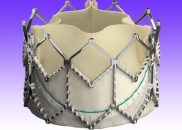In most severe aortic stenosis patients with pulmonary hypertension, transcatheter aortic valve replacement (TAVR) reduced pulmonary systolic pressure. There patients presented lower risk and lower all-cause mortality at short, median and long term. This data show that pulmonary hypertension should not be a TAVR contraindication. Pulmonary hypertension is common among TAVR patients. The most frequent…
Low-Risk TAVR Trending in All Papers
Transcatheter aortic valve replacement (TAVR) in low-risk patients with symptomatic severe aortic stenosis appears to be safe at one year. In a follow-up using computerized tomography (TC), hypoattenuated leaflet thickening was observed in a minority of patients, but it did not have a long-term hemodynamic impact. It should be noted that the management strategy for…
Safe for 80-Year-Olds. Should Nonagenarians be Withheld from TAVR?
According to this large global registry, mortality after transcatheter aortic valve replacement (TAVR) is twice as high in nonagenarians as against the “younger” group (90 patients. Additionally, risk scores cannot be trusted given that on the one hand they were designed for patients with planned surgery, and on the other hand, they included few patients…
Outpatient Rhythm Monitoring After TAVR Could Save Us from Some Pacemakers?
Delayed high-grade block after transcatheter aortic valve replacement (TAVR) goes unnoticed in patients undergoing TAVR without prior conduction disorders because, most times, it takes place during hospitalization or immediately after the procedure. Right bundle branch block is a risk factor, but it has poor sensitivity for the prediction of high-grade blocks, and there may be…
Post TAVR New Onset Left Bundle Branch Block at Long Term: Worth Our Attention?
After post TAVR mean 3-year follow-up, a new onset persistent left bundle branch block (LBBB) was not associated with higher mortality or hospitalization for cardiac failure according to this study to be published soon in J Am Coll Cardiol Intv. Nevertheless, LBBB was associated to higher risk of definite pacemaker and a negative impact in…
Good News at 3 Years for “Valve-in-Valve”
In this new era, the paradigm to treat the whole spectrum of transcatheter aortic valve replacement (TAVR) patients has started to shift beyond risk. However, broadening the spectrum raises the question of durability, which is why any long-term TAVR outcomes in any context are welcome. This specific study studied TAVR durability in the treatment of…
EuroPCR 2019 | Most Recent TAVR Meta-Analysis: The Spectrum of Treatment Reaches All Patients
This new meta-analysis combines all randomized transcatheter aortic valve replacement (TAVR) vs. surgical aortic valve replacement trials and expands the scope of TAVR. Evidence across the range of risk studied supports a paradigm shift in patients with symptomatic severe aortic stenosis. The clinical superiority of TAVR compared with surgery has been demonstrated across the spectrum…
EuroPCR 2019 | TRILUMINATE: Tricuspid Repair with Clip Improves Regurgitation and Quality of Life
Transcatheter therapy offers a promise for a largely forgotten valve given the lack of therapeutic options. Percutaneous edge-to-edge repair with clip seems to offer some hope to patients with tricuspid regurgitation according to the TRILUMINATE. At 30 days, transcatheter repair with clip significantly reduced tricuspid regurgitation at least in one grade in most patients, which…
EuroPCR 2019 | CHOICE: Balloon-Expandable Valves vs. Self-Expanding Valves in High-Risk Patients
The CHOICE trial included 241 patients with severe aortic stenosis and high surgical risk who underwent transcatheter aortic valve replacement (TAVR) using transfemoral access. These patients were randomized to balloon-expandable valve (Edwards Sapien XT) vs. self-expanding valve (Medtronic CoreValve). The endpoints were all-cause mortality, stroke, readmission, valve function parameters as measured through an ultrasound, and…
TAVR Still Gaining Ground Among Low-Risk Patients
Transcatheter aortic valve replacement (TAVR) has become the standard of care for patients with severe aortic stenosis and high surgical risk, and it should be considered as an option for intermediate-risk patients. In recent years, the number of low-risk patients treated with TAVR has increased. This study analyzes low-risk patients from the German Aortic Valve…
We Must Still Fear the “Big Five Complications” After TAVR
Surgical risk scores cannot be used for transcatheter aortic valve replacement (TAVR) and they usually overestimate procedural risk. There are 5 big complications after TAVR, specifically, that cannot be predicted by conventional surgical scores. These 5 peri-procedural complications are considered important because they have a somewhat significant impact on survival after TAVR. They are: 1)…










